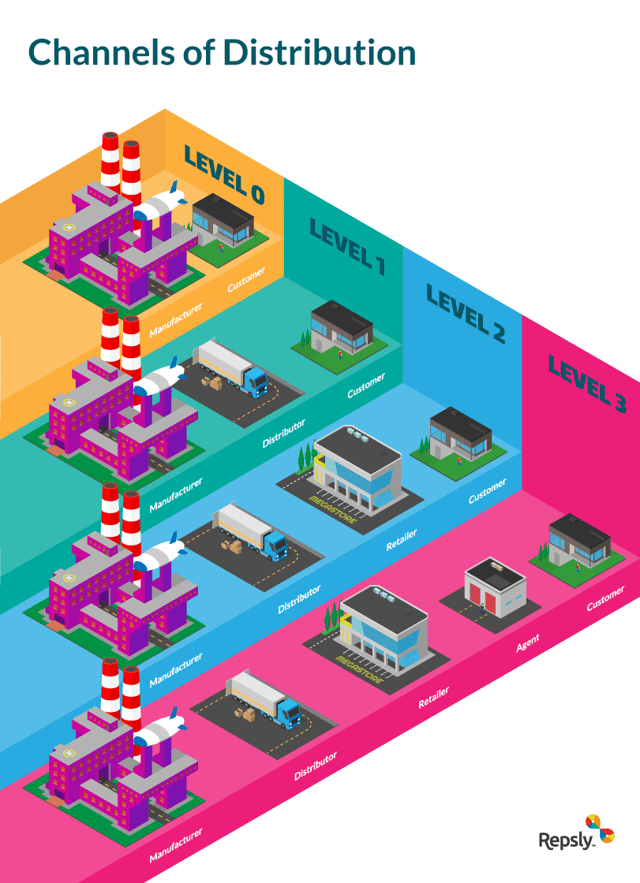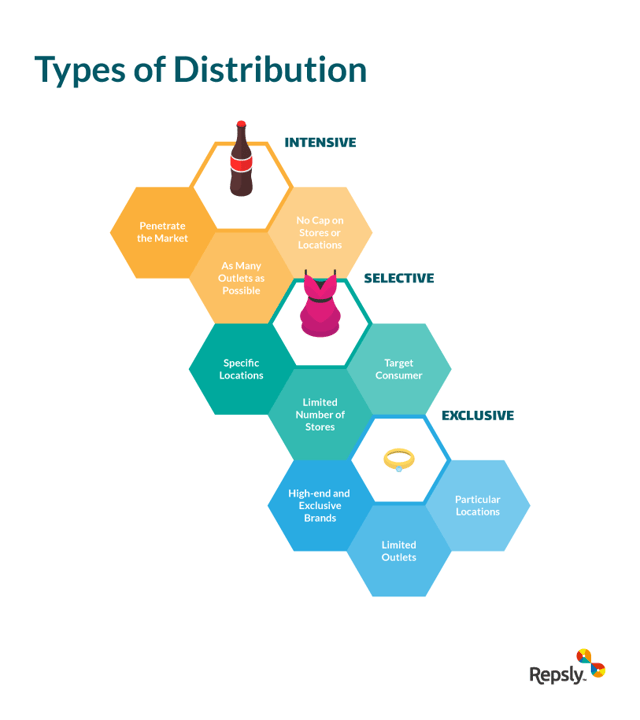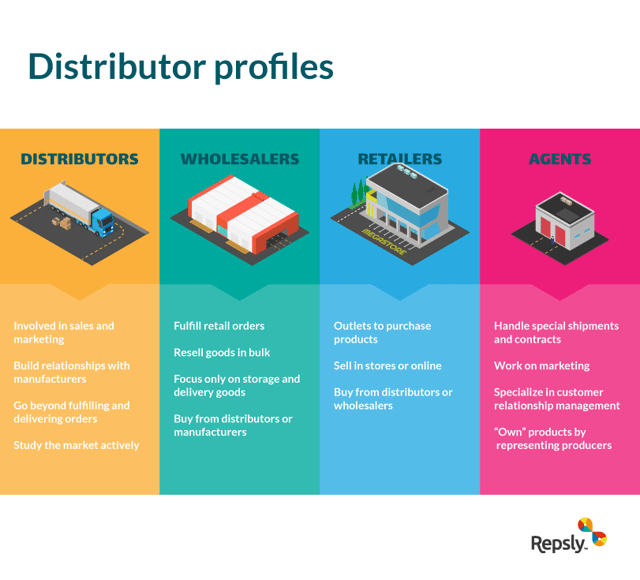When expanding into new markets, the best brands know that staying on top of their entire sales process is critical to sealing the deal. But how can you stay on top of your sales process if you aren’t engaged in it each step of the way? Product distribution is one important step that often goes overlooked as brands opt for the cheapest or easiest option rather than devising a legitimate distribution strategy. In this post, we will tell you everything you need to know about product distribution, from different distribution strategies to who is who in the industry, so you can refine your own distribution strategy to achieve peak performance on the shelf.
2. Distribution's Favorite Channels
3. The Three Types Of Distribution
4. Who's Who?
What Is Product Distribution?
Let’s get technical. Distribution entails making a product available for purchase by dispersing it through the market. It involves transportation, packaging, and delivery. Distribution is fundamental to a company’s sales.
A distributor is defined as someone who purchases products, stores them, and then sells them through a distribution channel. They are in between manufacturers and retailers or consumers, working on behalf of a particular company as opposed to representing themselves. Usually, distributors partake in collaborative relationships with clients and manufacturers.
The right distributor enhances a company’s exposure in the product market and can give an edge in terms of speed and efficiency.
Know Your Product Distribution Channels
A distribution channel refers to the flow of business that occurs between a manufacturer and a consumer. It is the path that a transaction follows. Distributors are the intermediaries that deliver and house products for producers to sell to retailers. These channels can be relatively simple or increasingly complex.
There are direct and indirect channels. In a direct channel, the producer works directly with the consumer. An indirect channel, on the other hand, incorporates intermediaries into the sales flow. There are four levels that break down the flow between manufacturers and consumers. When looking to expand into new markets or switch up your distribution strategy, you need to know the different levels of distribution.

Level Zero: A level zero distribution channel is the simplest. It involves a direct sale from manufacturers to consumers with no intermediary.
Level One: A level one channel has one intermediary as the middleman between the producer and consumer. An example is a retailer between manufacturer and consumer.
Level Two: When thinking about levels, associate the number to the number of intermediaries. In this case, a level two channel involves two intermediaries between producer and consumer. An example here would be a wholesaler selling to a retailer who then sells to the consumer.
Level Three: Here’s where an agent or broker comes in. Agents work on behalf of companies and deal primarily with wholesalers. From here, the wholesalers sell to retailers who then sell to consumers.
The Three Types of Distribution
Distribution strategies depend on the type of product being sold. the trick is knowing what type of distribution you will need to achieve your growth goals. There are three methods of distribution that outline how manufacturers choose how they want their goods to be dispersed in the market.

- Intensive Distribution: As many outlets as possible. The goal of intensive distribution is to penetrate as much of the market as possible.
- Selective Distribution: Select outlets in specific locations. This is often based on a particular good and its fit within a store. Doing this allows manufacturers to pick a price point that targets a specific market of consumer, therefore providing a more customized shopping experience. Selective distribution caps the number of locations in a particular area.
- Exclusive Distribution: Limited outlets. This can mean anything from luxury brands that are exclusive to special collections available only in particular locations or stores. This method helps maintain a brand’s image and product exclusivity. Some examples of companies that enact exclusive distribution would be high-end designers like Chanel or even an automotive company like Ferrari.

Distributors: A distributor is a wholesaler who assumes extra responsibility. In addition to fulfilling retailer orders, they actively sell products on behalf of the producers. From managing orders and returns to acting as a sales representative, they go beyond being the middleman between retailers and producers. They perform market analysis and are constantly searching for new opportunities to achieve peak sales performance. A distributor focuses on a particular area and market which allows them to cultivate strong relationships with manufacturers. Unlike a wholesaler, they most likely have a stronger affiliation with particular companies. Distributors have a direct responsibility to making sure products are flying off retail shelves.
For example, one distributor may work out an agreement with a popular beverage company who works with them regularly, whereas wholesalers are used on a need-by-need basis. They have the option to sell to retailers and other sellers, or directly to consumers and businesses.
Wholesalers: A wholesaler fulfills orders of retailers, by reselling goods, often in large quantities for manufacturers. Wholesalers purchase in bulk, typically, which lowers the price, from either distributors or manufacturers. This allows wholesalers to make a profit because they are able to sell the to retailers in smaller packages that yield higher prices. Unlike distributors, wholesalers only deal with the storage and delivery of goods. But, in certain cases, you have to go through a wholesaler to get to a distributor.
Retailers: Retailers are the outlets where consumers can purchase products. This is your local grocery store or Walmart down the street. They can sell through storefront locations or through online channels. Retailers purchase products from distributors or wholesalers.
Brokers and Agents: Make way for agents. They handle the logistics of the sales. Agents handle contracts, marketing, and pulling together specialized shipments. A part of their job is customer relationship management. On behalf of manufacturers, they take ownership of products through the distribution process. They represent the producer in the sales process.
Succeeding Working With a Distributor
When working with distributors, brands have a responsibility to oversee the process and prevent retail execution errors like out of stocks and distribution voids. This requires setting up clear lines of communication between managers, sales teams, and distributors to ensure you get that information as clearly and quickly as possible. Brands that are on top of their game form better relationships with their distributors and open up opportunities for expansion much easier than brands that communicate on an ad hoc basis.
While emails and text messages may suffice for quick fixes, these simply won’t work long-term. Let's say your sales rep informs you about an out of stock at location X. You might be able to remedy the situation by contacting your distributor and ordering another shipment to that location. But if location X is continuously experiencing out of stocks, the trend may fly under your radar if the only evidence you have is a few email threads buried deep in your inbox. Your random ordering pattern may make it difficult to forecast demand, or keep distributors and retailers from receiving predicting shipments. This is where data tracking and analytics become your best friend.
When you equip your team with the tools to constantly provide you with field insight, any recurring issues will become obvious much more quickly. Say that instead of you receiving an email or text each time something was awry in the field, you received a data point that you could instantly compare to past data and use to identify any patterns instantly. Now, rather than your distributor having to constantly fulfill last-minute shipments each time location X experiences an out of stock, you can begin sending extra product with each scheduled shipment, making your and your distributor’s life easier.
With so many different orders to fill and clients to keep up with, having a data tracking system in place will make your and your distributor’s hard work worth it. If there is a hiccup in the distribution network, you are empowered to glide past it with ease and maintain a consistent presence on store shelves, keeping distributors, retailers, and customers happy.

![Product Distribution Strategy: The Ultimate Guide [Infographic]](https://www.repsly.com/hs-fs/hubfs/Repsly%20Web/Blog%20and%20Email/Blog%20Graphics/Channels%20of%20Distribution.png?width=770&height=404&name=Channels%20of%20Distribution.png)





